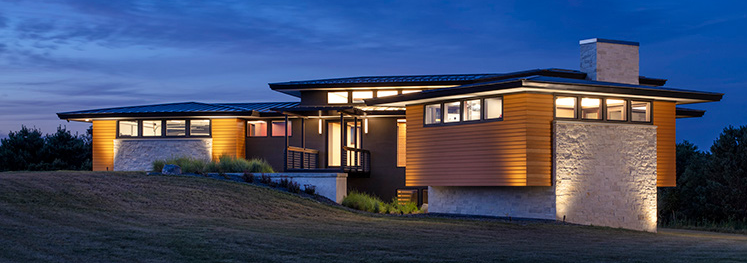This spring, I went on a wildflower walk at the Conard Environmental Research Area (CERA), a prairie reserve owned and managed by Grinnell College about 10 miles southwest of Grinnell, Iowa. It had just rained, and the wind was blowing dark storm clouds towards us from the west. Surrounded by the sound of swaying trees, we hiked through a forested section of CERA where bunches of newly green plants were sprouting delicate, white flowers. I was reminded of a statement from the famed architect Louis H. Sullivan: “observe how rhythmically the seasons follow the sun. Note their unfailing spontaneous logic, their exquisite analyses and synthesis, their vital, inevitable balance” 1 (emphasis original). He was telling architects to imbue their design with abstract characteristics such as beauty, rhythm, and balance—characteristics which make real contributions to the way we feel when we are in nature. Following Sullivan’s urging, a group of American architects that included Frank Lloyd Wright, Walter Burley Griffin, and Marion Mahony Griffin (Walter’s wife) would introduce the long, horizontal lines that characterize much of the prairie environment throughout the American Midwest into their design. Iowa, close to the movement’s epicenter in Chicago, Illinois, would become home to numerous examples of Prairie Style buildings which would form an important part of the state’s architectural history.
I was first exposed to Prairie Style in a place not known for its prairie: my hometown of Phoenix, Arizona. My father was a general contractor, and our family lived in a home he built in north Phoenix when I was young. My parents were both fans of Frank Lloyd Wright, so they asked their architect to design a Wright-inspired home. They had another request, though, which was that the house not feel “cold,” a side effect of modern designs which employ a large amount of steel and concrete or maintain the monotone colors of industrial materials. A “warm” modern house could be described as mixture of a modern house and a traditionally styled house; instead of steel and concrete, it employs materials like wood, stucco, and brick. Instead of flat roofs with no chimneys, it employs peaked roofs with broad chimneys. In Frank Lloyd Wright’s body of work, his Prairie Style houses most fit this description, so my parents essentially built a Prairie Style house in the desert. They told me I was living in a Prairie Style house even though I had no conception of what a prairie looked like.
When I moved to Grinnell, Iowa, for college, I did not realize I would be within walking distance of two important Prairie Style buildings: the Merchants’ National Bank, designed by Sullivan, and the B. J. Ricker House, designed by Walter Burley and Marion Mahoney Griffin. Only after I discovered these buildings did I realize that, since I was now in the prairie region, I could expect to see more Prairie Style architecture. Yet, aside from the examples built in the early 20th century, around the time Frank Lloyd Wright was practicing in his Oak Park, Illinois, studio, Prairie Style architecture is relatively rare in Iowa. This raised an interesting question: why is a style named after the prairie no longer popular in a state practically defined by its prairie? To find the answer, I examined three Iowa buildings designed by three different Prairie Style architects: the City National Bank and Park Inn Hotel by Frank Lloyd Wright in Mason City, Iowa, and the B. J. Ricker House and Merchants’ National Bank Building, both in Grinnell.
The City National Bank and Park Inn Hotel
In 1972, H. Allen Brooks published one of the definitive histories of Prairie Style architecture, The Prairie School: Frank Lloyd Wright and his Midwest Contemporaries. According to Brooks, Frank Lloyd Wright designed this unique combination of a hotel, bank, and law office in Mason City, Iowa, in 1908. J. E. E. Markley, a bank director and attorney, commissioned Wright after he visited his eldest daughter at the school she attended in Spring Green, Wisconsin. Her school, the Hillside Home School, had been designed by Wright, and Markley was impressed by it. 2 Wright faced a challenge when designing the City National Bank and Park Inn Hotel, however: he had been commissioned to design in one building three separate spaces whose purposes sometimes conflicted with one another. For example, a hotel should appear inviting to potential guests, but banks at the time were meant to be imposing to convey a sense of security. The building is therefore a balancing act, but in masterfully striking this balance.
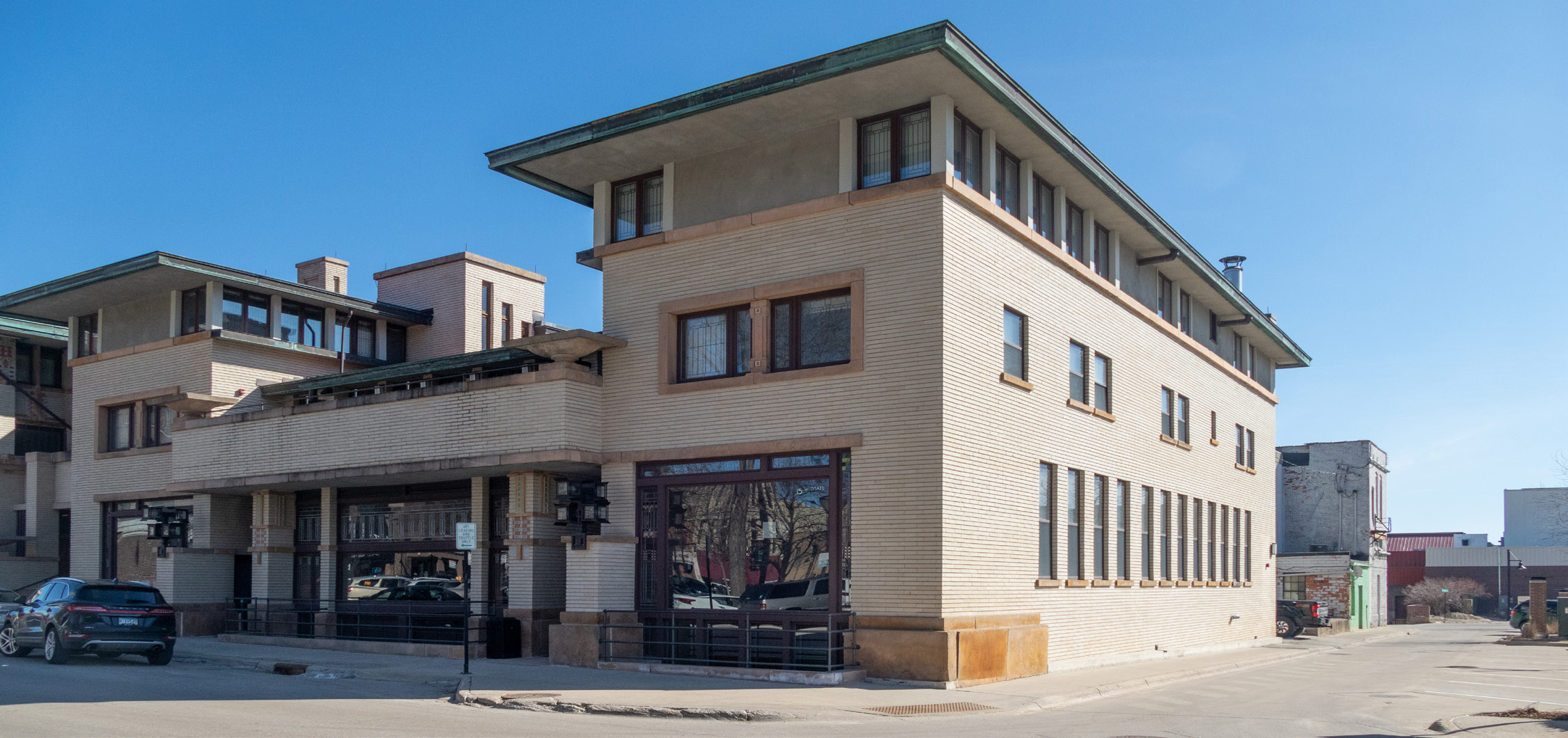
The City National Bank and Park Inn Hotel
Viewed from Mason City’s Central Park, the left side contained the City National Bank; the lower, middle section housed the law offices of Blythe, Markley, Rule and Smith, while the right side housed the Park Inn Hotel. Today, the Park Inn Hotel takes up the entire building, with the City National Bank side converted to a ballroom and the law offices now housing hotel management. Immediately visible are characteristics which defined the Prairie Style: the roof is long and low, extending off the building to create large eaves. Bands or ribbons of windows characterize the facade and are complemented by geometric ornamentation in the form of colorful tilework. The roof line, windows, windowsills, and even the brickwork all emphasize the horizontal, while vertical elements such as pillars or broad, anchoring chimneys create contrast. These characteristics define the Prairie Style: using horizontal, simple forms, they create a sense of monumentality and rootedness within the site.
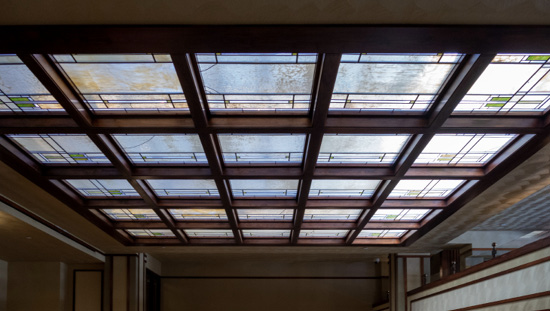
The City National Bank and Park Inn Hotel skylight room
The Prairie Style also entailed innovations in interior design, as architects such as Wright and Griffin began to open up the compartmentalized interior spaces that were common in older architectural styles. The interior of the City National Bank and Park Inn Hotel offers a Wright masterclass in manipulation of light and space. A ribbon of geometric stained-glass windows beckons potential guests off the street into the hotel. Once inside, I was immediately greeted by the imposing wall forming the balcony of the second-floor mezzanine. Underneath the mezzanine is the check-in desk, which is intentionally cramped by the mezzanine ceiling. Through a set of folding doors behind the check-in desk is a two-story room lit by the soft light of geometric stained-glass skylights, a scene that stunned me when I first walked into the building. Wright designed the stained glass to reflect the colors of autumn, and, combined with the natural colors of the Arts and Crafts style furniture, the light in the room had a pleasantly warm effect, a startling contrast to the cold Iowa weather of that day.
I would be remiss not to mention the restoration of the building by the Wright on the Park Foundation, which was formed to restore the City National Bank and Park Inn Hotel following considerable alterations and deterioration that occurred over its history. 3 A contributor to this restoration was Scott Borcherding, an interior designer with the Mason City architecture firm Bergland + Cram. I interviewed him about the restoration and his thoughts on the Prairie Style, and he described an exhaustive restoration process that took place over several years involving multiple stakeholders, including the National Park Service and the community of Mason City. Preparations for the restoration included interviews conducted with former hotel guests and construction crews that had worked at the building, while restorers poured over Wright’s original plans and determined the evolution of the building over its history. Many parts of the design had been cannibalized over the years: security bars originally installed over the bank window had been used as a fence for a home in Clear Lake, Iowa, and one of the statues of the Roman god Mercury that had stood in the bank is rumored to have ended up in California. Scott said the core of the restoration effort from the beginning was a conviction that “we didn’t want to be the ones who tore [the City National Bank and Park Inn Hotel] down. We had to save it.”
Both Scott and the docent of my tour at the City National Bank and Park Inn Hotel, Jim Collison, told me that one of the most exciting moments of the restoration involved the beautiful art glass in the skylight room. Almost immediately after the hotel opened, the skylight panels began to leak, so they were taken down and essentially lost to history. They were rediscovered, however, in a Prairie Style building in Mason City: the Walter Burley Griffin-designed Blythe House. An expert in the Prairie Style who stayed in the home (which is still a private residence) was meditating in the sunroom, looked up, and realized they were looking at a priceless collection of Frank Lloyd Wright original art glass! The homeowner, also a Prairie Style expert, then donated the glass to the Wright on the Park Foundation, and it was restored to its original position in the skylight room.
Scott said that there were many in Mason City at the beginning of the restoration who were worried about the price tag and the potential involvement of taxpayer dollars. The group went ahead with the project regardless, and when they opened the building to the community, a line of hundreds stretched into Central Park. Scott said that “we changed a lot of minds that day. People came up to me and said, ‘I thought you were crazy, but I was wrong.’”
The B. J. Ricker House
Nestled on the corner of a residential neighborhood at 10th Avenue and Broad Street in Grinnell, Iowa, stands a home designed by Walter Burley and Marion Mahoney Griffin in late 1910 or early 1911 for B. J. Ricker. 4 Walter Burley Griffin was a pivotal contributor to the Prairie Style movement, and the B. J. Ricker House amounts to a departure from the influence of Wright, with whom Griffin had worked at Wright’s Oak Park, Illinois, studio. The house bears the hallmarks of the Prairie Style: the Broad Street facade had two ribbons of windows, with windowsills, roof line, and brickwork forming long horizontals, as well as wide, anchoring chimneys. Burley Griffin, in contrast to Wright, employed gabled instead of hipped roofs. His work, including the Ricker House, also has a greater sense of monumentality. The roof seems to rest on four great pillars, one to each corner, and the house rests on a wide concrete foundation, a relatively new building practice in the era.
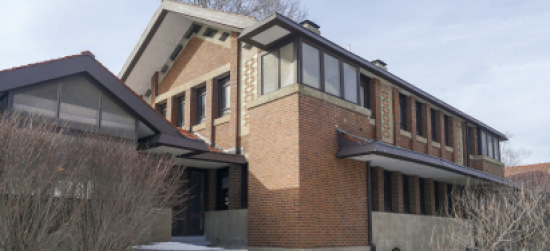
B. J. Ricker House in Grinnell, Iowa
The decorative panels between the windows on the second floor are tile, brick, and plaster, and were designed by Marion Mahony Griffin, an excellent architect and draftswoman who helped define the Prairie Style. She also designed a centerpiece Japanese-motif tile mosaic above the fireplace as well as the geometric ornamentation of the windows. 5 Determining the exact contributions of either Griffin to the designs the couple produced is a difficult task, as “Mahony Griffin was such a fierce cheerleader of her husband…that she happily painted herself in his background.” 6 Before she worked with Walter, Marion maintained an impressive solo career. When Wright abruptly left for Europe in 1909, it was Marion who finished most of his remaining projects, culminating in a design for Henry Ford in 1912. 7 Eventually, she would produce the renderings for Griffin’s winning submission for the design of Australia’s capital city of Canberra. Her renderings of the B. J. Ricker House are at the Grinnell College Museum of Art. Despite her architectural training and impressive design portfolio, architectural historians dismissed her design work, focusing instead on her renderings and relationship with Walter. For example, historian Allen H. Brooks hypothesized that “she lacked the imaginative mind to create a wide and rich variety of outstanding designs.” 8 In reality she was a pioneer in a traditionally male-dominated field and a gifted architect whose contributions to the design of the B. J. Ricker House are illustrative of her talent.
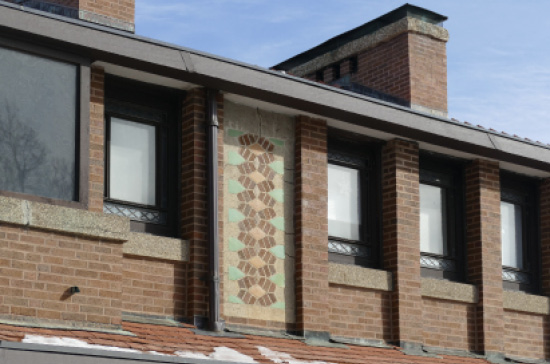
An exterior decorative panel designed by Marion Mahony Griffin
The interior of the home employed an L-shaped plan, an innovation of Walter’s, who was a master at laying out interior space. By organizing the kitchen, dining room, and living room around the fireplace, Walter created a natural flow between rooms while still maintaining their separate functions. 9 You can walk into the dining room from the kitchen, and from the dining room you walk around a fireplace (forming the L) to get to the living room, the natural location for the hearth. Walter also fit five bedrooms and three bathrooms onto the second floor, with the tops of each corner pillar forming sleeping porches. A garage addition designed by Prairie Style architect Barry Byrne was added later.
The Griffins would go on to design Rock Crest Rock Glen, a neighborhood development in Mason City that rests on bluffs flanking Willow Creek. It was while they were completing their work there that Walter won the Canberra competition and was hired by the Australian government to oversee construction. Had he stayed in America, his body of work might have gone on to rival Wright’s in terms of its significance to American architecture. His career was tragically cut short when he died at the age of 60 of peritonitis while in India working on another commission.
Like the homes of Rock Crest Rock Glen, the B. J. Ricker House–formerly owned by Grinnell College but now the home of Ryan Ferguson and his family. I took pictures of the B.J. Ricker House at Ryan Ferguson’s gracious invitation, and I had the chance to talk to him about his thoughts on living in a Griffin designed home. He also sent me an essay he wrote about the experience for the Walter Burley Griffin Society of America. In his essay, he writes that “Walter Burley Griffin is noted for designing wonderful floorplans, which perhaps can best be appreciated by active children.” 10 Ferguson and his family face the unique situation of living in a piece of architectural history. Their home is furnished with period-correct Stickley furniture, but Ferguson worries about the hard wooden edges his kids keep running into, and the family purchased a more comfortable Ikea couch for their living room. He faces a constant stream of projects to maintain the home, so he has to balance his desire for preservation with the rest of life’s demands, including spending time with his family. Despite these and other challenges (they’ve done lots of insulation work to keep heating bills manageable for a home built in a time without modern insulation), Ferguson’s family enjoys living in the B.J. Ricker House, a testament to the strength and beauty of Griffin’s design, as well as the passion and patience of the family.
The Merchant’s National Bank
Titan of architecture Louis H. Sullivan designed the Merchants’ National Bank in Grinnell in 1914. 11 Located on the corner of Broad Street and 4th Avenue, the building is essentially a cube which Sullivan lined with art glass windows to introduce light into the interior. The 4th Avenue facade contains a rose window, while the facade facing Broad Street contains a ribbon of art windows separated by tall, narrow columns. The roof of the bank has a stained-glass skylight colored in a brilliant blue. The result is an imposing exterior that hides an ethereal interior, providing authority and a sense of wealth like that of a cathedral. It is a beautiful composition of form and light that characterizes the work of Sullivan and so many other Prairie Style architects.
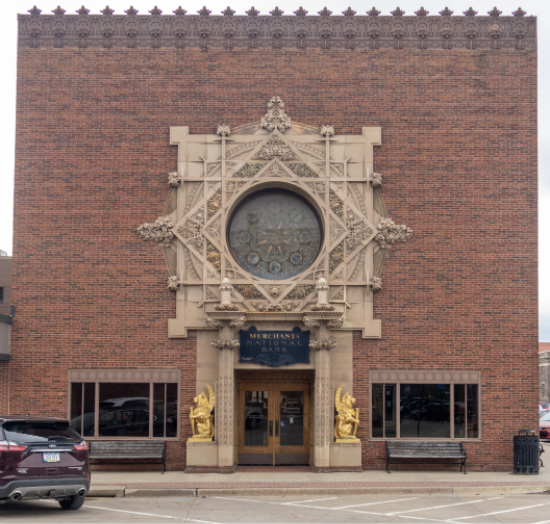
The Merchants’ National Bank 4th Avenue Facade
The bank’s exterior emphasizes authority and opulence, similar to Wright’s National Bank in Mason City. In contrast to the simplified geometric designs of Wright, however, Sullivan employed his signature terracotta ornamentation of swirling leaves and organic forms to surround the entrance and the rose window. Two winged lions flank the embedded columns framing the front door, further establishing the prestige of the bank. The narrow columns which intersperse the art glass windows on the Broad Street facade emphasize the verticality of the building and the thinness of the brick walls. The facade is capped by more terracotta decoration, which form spike-like clusters against the sky. For Sullivan, this intricately detailed exterior sculpture was a way to integrate natural forms into his architecture, a philosophical idea he would articulate for the Prairie School in writings and speeches like the one I quoted at the beginning of this essay. He believed nature was characterized by “the beauty, the exquisite spontaneity, with which life seeks and takes on its forms in an accord perfectly responsive to its needs.” 12 It was from this belief that he derived the famous axiom, “form ever follows function” 13—meaning the design of a building should reflect its purpose, as the forms of nature reflect the needs of organic life. The adornment of the Merchants’ National Bank, therefore, celebrates the role of the bank in facilitating commerce, and enshrines this function as occurring on the same level as the fundamental processes of nature.
The interior is marked by diffuse light from the art glass windows and more of Sullivan’s ornamentation. Oak trim and blackish-green marble counters recall natural colors and provide richness, while organic terracotta forms and two planters placed at the rear of the bank frame the entrance to the vault. When one walks from the rear of the bank towards the front entrance, the intricate rose window above the door comes into view, sitting above the oak trim of the entrance hall as if on a pedestal. Entering the Merchants’ National Bank was the second time during my research that I entered a space and was astounded by the light and color it contained. Like the first time I walked into the skylight room of the City National Bank and Park Inn Hotel, it was a cold day, and after feeling a sense of compression due to a low ceiling in the entry way, I suddenly found myself in an ethereal space full of warm colors and bathed in richly colored light.
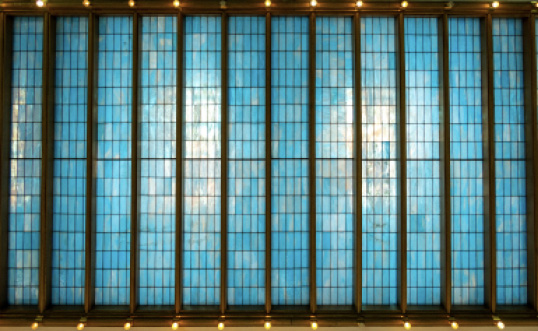
The Merchants’ National Bank skylight
The Merchants’ National Bank was one of the last commissions Louis H. Sullivan would receive in his life. The pinnacle of his career was in Chicago, where he pioneered the architecture of skyscrapers with his partner Dankmar Adler. Following Adler’s departure, an economic crash, and a revival of interest in older, more traditional styles of architecture following the 1893 Columbian Exposition, Sullivan’s career went into decline. His autobiography The Autobiography of an Idea ended with a denunciation of traditional architectural styles, and he died impoverished in 1924, with former associates contributing funds to pay for his funeral. 14 His legacy was that of his work in Chicago and his philosophical influence on the field of architecture. Many monumental architects, including both Wright and Griffin, cited their work with him and his views of architecture as being formative. The Merchants’ National Bank, though it was designed at the nadir of his career, is a breathtaking building in which Sullivan’s ideal of form following function is eloquently expressed.
The Prairie Style in the Modern Day
The City National Bank and Park Inn Hotel, B.J. Ricker House, and Merchants’ National Bank all illustrate the primary characteristics of the Prairie Style. They draw inspiration from nature and prioritize function over form, though in the end they weave function and form together. These architects brought natural light into innovatively designed interiors through ribbon and stained-glass windows. Their design was rooted in an appreciation of nature and a philosophical belief in the importance of artistic innovation. Their buildings also had a lasting impact on the communities they were built in. The official branding of both Mason City and the town of Grinnell employ Prairie Style motifs, and Prairie Style buildings serve as anchors for their respective downtowns.
Given the artistic significance of Prairie Style buildings, why is the style not more popular in Iowa today? First, it should be noted that the Prairie Style originated in Chicago, and what Jim Collison told me after our tour at the City National Bank and Park Inn Hotel is true: “the Prairie Style name is a misnomer.” Yes, Prairie Style architects cited the prairie as inspiration for the long horizontal lines of their architecture, and most of their buildings were in the American Midwest. But Brooks says that they thought of their movement as the Chicago School, as that is where it had formed and been perfected. The term “Prairie Style” was only applied later by art historians to distinguish the style from a preceding movement in Chicago commercial architecture which is best known for the birth of the modern-day skyscraper. 15 So, despite the word “Prairie” being in the name, outside of its higher integration with nature compared to preceding traditional architecture, Prairie Style architects were designing for the prairie simply because it was where they were receiving commissions.
Second, the Prairie Style abruptly lost popularity around 1914. Brooks claims the sources of the style’s demise were “cultural [and] sociological changes that culminated with the 1914-18 war” 16 that changed client preferences: a revival in traditional styles dried up Prairie Style work. The Prairie Style could not coexist with traditional styles, like Victorian or Colonial Revival, which were antithetical to the design philosophy articulated by architects such as Sullivan and Wright. Scott Borcherding described the Prairie Style as “kind of a reaction to Victorian design—[which, in comparison, was] very opulent, decadent, and layered, with surfaced things applied to make things pretty. A lot of those things had no function, only aesthetic, and they were honestly a little competitive with your neighbors.” When traditional styles experienced a resurgence of popularity before World War I, many Prairie Style architects had to return to the older styles or stop practicing—they could not adapt their style to the changing times.
Third, while the style as it existed in the early 20th century is not widespread in Iowa, many of its characteristics would go on to influence modernist and contemporary architecture, which is currently popular across the state. Modernism developed in Europe following World War I, but it was influenced by Wright’s pre-war work. Prairie Style cast off the rigid rules and opulence of traditional European styles and instead drew inspiration from nature, which allowed Prairie Style architects to simplify the designs for their buildings. This simplicity would be expanded upon in Modernism, with architects such as Mies van der Rohe simplifying residential architecture to essentially steel and glass boxes in projects like the Farnsworth House. Most current contemporary architecture is not this extreme, but it does integrate itself with nature and employ the simplified forms first experimented with by Prairie Style architects such as Wright, Griffin, and Sullivan.
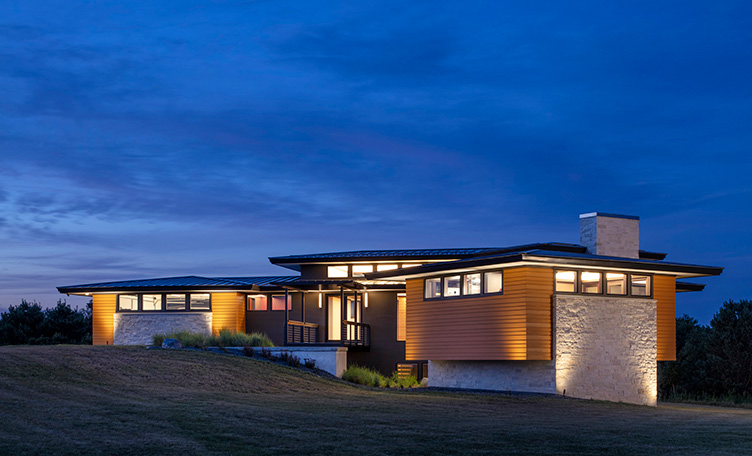
Intregrity in Thornton. Photo courtesy of AJ Brown Imaging
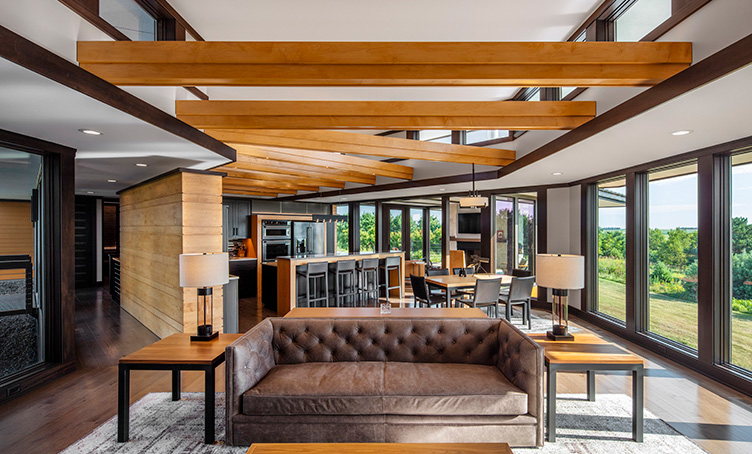
Intregrity in Thornton. Photo courtesy of AJ Brown Imaging
An example of contemporary Iowa architecture which integrates elements from the Prairie Style is the Integrity in Thornton Project, a residence designed by Bergland + Cram Senior Project Manager Joe Anderson. The house employs hipped roofs, ribbon windows, and is integrated with its site by occupying the crest of a small hill. Natural light pours into the home from ribbon and clerestory (above eye level) windows, both used extensively by Prairie Style architects. Natural materials including warm woods and stone are used, a broad chimney anchors the home, and there is no superfluous decoration. The home’s beauty comes from the home’s structure and materials. The interior is logically designed and flows throughout rather than being compartmentalized. The Integrity in Thornton Project, like much of cutting-edge architecture across Iowa, employs design characteristics that were first employed by Prairie Style architects—characteristics, however, which transcended the style, becoming critical components of modernist and contemporary architecture as well.
I talked with Joe Anderson about his thoughts on the Prairie Style and the role it plays in his work. He told me that Iowa punches above its weight for creating cutting edge architecture, and that energy codes and sustainability concerns are driving architects to design region-specific buildings, which means the built environment in Iowa is increasingly responding to its prairie surroundings. He also said that “just like any good architecture, the Prairie Style was a snapshot in time that provided a look into how we wanted to live, not how we were living.” Those words perfectly describe the Prairie Style: a step forward in our relationship with the built environment that would help define modern architecture, an important part of which took place in Iowa.
1 Louis Henry Sullivan, “The Young Man in Architecture,” The Architectural Review 9, no. 54 (1901): 214
2 Allen H. Brooks, The Prairie School: Frank Lloyd Wright and his Midwest Contemporaries, (Toronto and Buffalo: University of Toronto Press, 1972), 242
3 “WTOP History,” Wright on the Park, 2022, https://wrightonthepark.org/about-us/wotp-history/
4 Allen H. Brooks, The Prairie School, 173
5 Ryan Ferguson. “Ricker House, Ryan Ferguson Perspective,” 2020
6 Claire Zulkey, “Meet Marion Mahony Griffin, Frank Lloyd Wright’s best frenemy: The two architects are forever intertwined,” Curbed, June 8, 2017. https://archive.curbed.com/2017/6/8/15755858/marion-mahony-walter-burley-griffin-wright-drawings
7 Allen H. Brooks, The Prairie School, 164
8 Allen H. Brooks, The Prairie School, 164
9 “Walter Burley Griffin in his Own Right: The Griffins Architecture Interviews Producer’s Notes,” PBS, June 4, 1999, https://www.pbs.org/wbgriffin/index.htm
10 Ryan Ferguson. “Ricker House, Ryan Ferguson Perspective,” 2020
11 Allen H. Brooks, The Prairie School, 231
12 Louis Henry Sullivan, “The Tall Office Building Artistically Considered,” Lippincott’s Magazine, March 1896, 408
13 Louis Henry Sullivan, “The Tall Office Building Artistically Considered,” 408
14 H. Koeper, “Louis Sullivan,” Encyclopedia Britannica, accessed April 8, 2022 from https://www.britannica.com/biography/Louis-Sullivan
15 Allen H. Brooks, The Prairie School, 12
16 Allen H. Brooks, The Prairie School, 344

